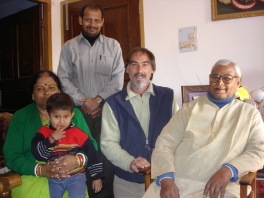était enseignant au BHU de Varanasi, musicien officiel de la radio nationale et concertiste. C'est auprès de lui, et grâce à son enseignement,
que j'ai appris (par cœur) le formidable répertoire de la Garana de Bénarès. Panditji nous a quitté en 2014, c'est toujours une grande peine
pour nous et tous ceux qui ont connus sa bienveillance.

Il est lui-même disciple de
Anokelal Mishraji, décédé en 1958, spectaculaire et
puissant, qui n'a jamais voulu que l'on fasse de lui ni une
photo, ni un enregistrement.
Le grand boss de l'école de Bénarès est Ram Sahai JI,
décédé en 1826; entre fils et disciples, cette garana a
donné les grands joueurs de l'histoire
du tabla: Mahapurush Mishra, Ishwari Lal Mishra, Sanju
(Vishnu) Sahai, Sharda Sahai, Samta Prasad, Kanthe Maharaj,
Kishan Maharaj, Kumar Bose.
Today, the
Benares tabla gharana is well known for its powerful sound,
though it is important to note that Benares players are
also very capable of
playing delicately and sensitively. The gharana is
categorized into the Purbi (eastern) baj, which includes
the Farukhabad, Lucknow, and Benares
gharanas. The Benares style makes use of the more resonant
strokes of tabla, such as Na (played on the lao), and Din.
Benares players preferentially
use the full-hand TeTe strokes, rather than the single
finger alternation preferred by the Delhi style, though
both stroke types are integrated into the
Benares baj repertoire. Benares tabla players are
successful in all forms of tabla playing, including tabla
solo, instrumental, vocal, and dance
accompaniment. The tabla solo is highly developed in the
Benares gharana, and some artists, such as Pandit Sharda Sahai,
Pandit Kishan Maharaj,Pandit Chhote Lal Mishra and Pandit
Samta Prasad, have become famous as tabla soloists.
 Tabla solo
à Pasadena en 1980
Tabla solo
à Pasadena en 1980